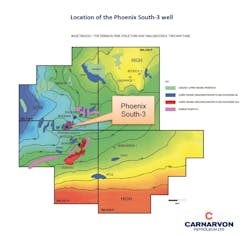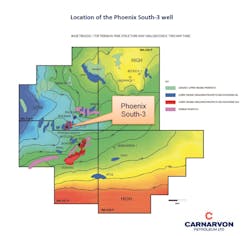Dorado-1 spud date slips behind Phoenix South-3
The Perth-based duo of Quadrant Energy Ltd. and Carnarvon Petroleum Ltd. has decided to delay the drilling of the prospective Dorado-1 wildcat well in the Bedout sub-basin off Western Australia until mid-2018. It will now follow the group’s second appraisal well on the Phoenix South oil and gas discovery.
The Quadrant-operated joint venture had planned to drill Dorado with a jack up rig during this year’s second half, but has now decided that there will be cost savings and more-efficient well operations in holding the well over to align with next year’s Quadrant drilling program. This also will minimize exposure to the southern hemisphere cyclone season.
It is still intended to use a jack up rig. Dorado will target multiple stacked reservoirs within the prospective Calley formation, which has yielded gas and condensate in the Roc-1, Roc-2, and Phoenix South-2 wells.
The JV says the top Calley sand alone has the potential to contain a gross mean recoverable prospective resource of 545 bcf of gas and more than 30 million bbl of condensate.
The Phoenix South-3 appraisal is expected to spud during early 2018. Essentially it will be a redrill of the aborted Phoenix South-2 well, which was drilled last December.
PS-2, in WA-435-P, encountered a 39-m thick hydrocarbon-bearing zone with significant gas influx and elevated reservoir pore pressure at or near the Caley formation primary target.
However, the group was unable to assess up to 185 m thickness of additional potential hydrocarbon-bearing Caley reservoir below a 5,215-m well depth because of the higher-than-anticipated pressures.
The Phoenix South structure Calley reservoir is estimated to contain a gross mean recoverable prospective resource of 489 bcf and 57 million bbl of associated condensate. The condensate-to-gas ratio is high and adds value to the prospect.
In addition, the original Phoenix South-1 discovery well found oil in the stratigraphically higher Barret sandstone.
The JV says the primary objective of PS-3 will be to specifically evaluate the Calley interval that PS-2 was unable to fully penetrate and test.
The new well will be drilled with a semisubmersible drilling rig and tenders will be released within the next few weeks.
In the nearby Roc discovery, the JV has commenced pre-front-end engineering and design work, including detailed reservoir modelling, to determine the most appropriate development concept. The northern extent of the Roc reservoir will be a primary focus to provide greater certainty of the gas-condensate resource and reclassification of volumes into the proven category ahead of a final investment decision.
All the development scenarios being considered include options for tie-back of future discoveries and appraisal successes. These include the potentially larger Phoenix South field and the Dorado prospect.
Quadrant is operator with 80%. Carnarvon holds the remaining interest.

